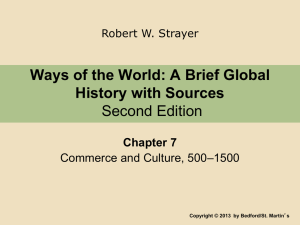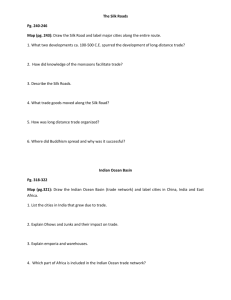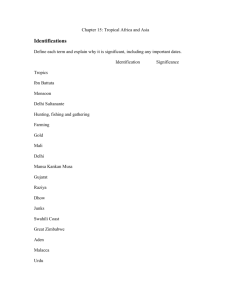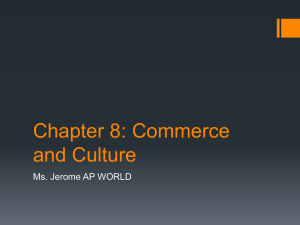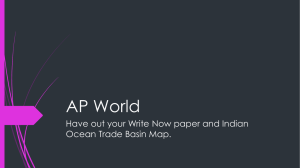America: A Concise History
advertisement
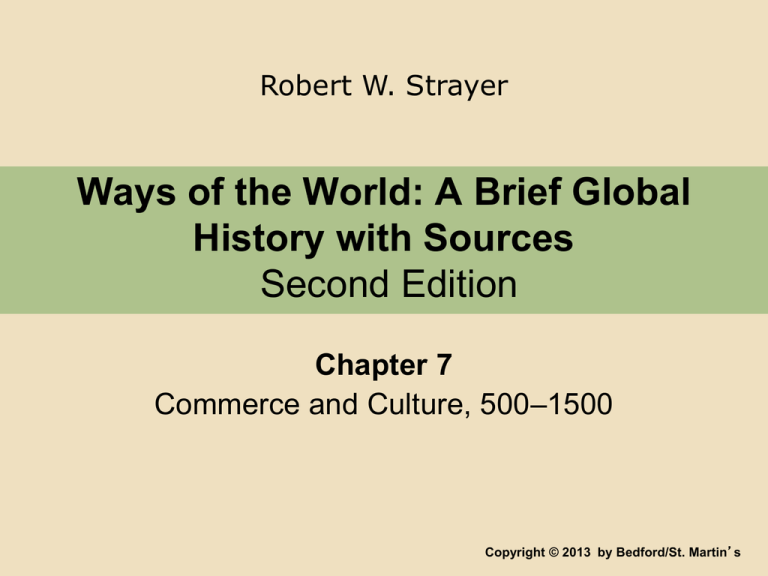
Robert W. Strayer Ways of the World: A Brief Global History with Sources Second Edition Chapter 7 Commerce and Culture, 500–1500 Copyright © 2013 by Bedford/St. Martin’s I. Silk Roads: Exchange across Eurasia A. The Growth of the Silk Roads 1. Inner and Outer Eurasia 2. Pastoral people in motion 3. Indirect connections between empires I. Silk Roads: Exchange across Eurasia B. Goods in transit 1. Luxury goods such as silk 2. Women as producers and consumers 3. China and other centers of silk production I. Silk Roads: Exchange across Eurasia C. Cultures in Transit 1. Buddhism on the road 2. New forms of Buddhism: Mahayana I. Silk Roads: Exchange across Eurasia D. Disease in Transit 1. Smallpox and measles in Han and Rome 2. Bubonic plague in Byzantium and elsewhere 3. Mongols and the Black Death Silk Roads II. Sea Roads: Exchange across the Indian Ocean A. Weaving the Web of an Indian Ocean World 1. Malay sailors in East Africa 2. New technologies 3. India as the fulcrum 4. Impact of China 5. Islam and trade II. Sea Roads: Exchange across the Indian Ocean B. Sea Roads as a Catalyst for Change: Southeast Asia 1. Srivijaya, 670–1075 2. Khmer kingdom of Angkor, 800–1300 3. Borobudur and Angkor Wat 4. “Indianization” II. Sea Roads: Exchange across the Indian Ocean C. Sea Roads as a Catalyst for Change: East Africa 1. Swahili 2. Rise of Islamic trade 3. Lamu, Mombasa, Kilwa, and Sofala 4. Cultural fusions 5. Muslim Africans 6. Great Zimbabwe The Swahili Coast of East Africa In the trading ports the Muslim influence was strong. Much of the other population remains traditional with very little Islamic influence outside of cities! A. Coastal Ports – Mogadishu, Kilwa, etc. 1. Mixture of people – Arabian, African, Asian 2. Blended culture of these ports a. Swahili language – Bantu based, Arabic influenced b. Active Indian Ocean trade with Asia (India, China) The Swahili Coast B. Cultures of the Swahili Coast 1. Islam unifies the rulers and merchants…allows them to exist with a somewhat common culture a. Most of the regular population didn’t convert to Islam 2. Swahili allowed a vibrant culture to develop The Swahili Coast III. Sand Roads: Exchange across the Sahara A. Commercial Beginnings in West Africa 1. Environmental variation around the Sahara 2. Sudanic West African trade and urban centers III. Sand Roads: Exchange across the Sahara B. Gold, Salt, and Slaves: Trade and Empire in West Africa 1. Camel caravans carrying gold and salt 2. Wealthy empires based on trade 3. Women in the workforce 4. Slave trading 5. Cosmopolitan cities II. African Grassland Kingdoms The Sudanic States 1. Ghana, Mali, Songhai(y)…West Africa 2. The Sahel – exchange zone between North and tropical Africa 3. Gold-salt trade Caravans across Sahara reached the Sahel. This was the transfer point for Islam! Ghana 1. Gold-salt trade route 2. Rulers converted to Islam by 10th century a. Much of the population did not convert Empires of the Western Sudan Empire of Mali 1. Malinke peoples 2. Muslim kingdom 3. Gold - salt trade…also agriculture 4. Griots – professional oral historians 5. Sundiata – the “Lion Prince” 6. Mansa Musa…the gold Hajj a. Showed incredible wealth Empires of the Western Sudan Trade Cities a. Jenne and Timbuktu b. Niger River c. Centers of religion –mosques d. Centers of culture – libraries and universities Songhay 1. Middle Niger valley 2. Established by Sunni Ali (1464-1492) – expanded Songhay territory 3. Like Mali, made $$ as a middleman in the gold trade 4. Askia – military title taken by rulers of Songhay 5. Elites were Muslim – people remained animistic 6. Defeated by Muslim army from Morocco, 1591 – firearms Mosque at Jenne In both politics and Slavery and Islam society, the Sudan 1. Slave trade between Africa and became a mixture of Muslim world Muslim, indigenous traditions 2. Muslim views on slavery a. Demand: women and children b. Slave usage – all areas of society IV. An American Network: Commerce and Connection in the Western Hemisphere A. B. C. D. Geographic barriers Regional trade networks Mayan and Aztec trade Incan roads V. Reflections: Economic Globalization— Ancient and Modern A. B. C. D. Luxury goods of the ancient world Mass consumption in the modern world Multi-polar ancient economy Western dominance in the modern economy


